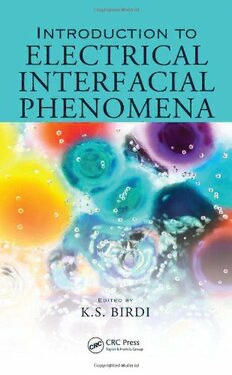Download Introduction to Electrical Interfacial Phenomena PDF Free - Full Version
Download Introduction to Electrical Interfacial Phenomena by Birdi K.S. in PDF format completely FREE. No registration required, no payment needed. Get instant access to this valuable resource on PDFdrive.to!
About Introduction to Electrical Interfacial Phenomena
With the rapid development of nanotechnology, the surface-to-volume ratio of objects of interest continues to increase. As such, so does the importance of our ability to tailor interfacial properties. Written by bestselling author and internationally renowned researcher K.S. Birdi, Introduction to Electrical Interfacial Phenomena offers comprehensive coverage of the field of electrical double layer (EDL) research. Birdi discusses theoretical models used with EDL and demonstrates how they can be applied to typically encountered real-world problems, including those that must be considered in modern industrial applications. The book explains the EDL through fundamental theory and real-world solved examples from applications such as corrosion, aerosols, dispersions and emulsions, adhesion, storage batteries, waste-water treatment, enhanced oil recovery, biology (proteins at cell membranes), and macromolecules. After introducing the electrical interfacial phenomenon, it describes advanced systems, provides a comprehensive description of the double layer, and presents bonus material on advanced theory separate from the main text. The book also includes application examples that demonstrate EDL analyses to new and developing areas such as enhanced oil recovery, storage batteries, hydrogen fuel cells, and biology. While there are many books available on this topic, so far none have taken a combined application and fundamental theoretical approach to the problem. Collating available information drawn from the extensive literature on various models of EDL into a comprehensive resource, this book paints a picture of the state of an art that is on the brink of further development. It not only delineates theoretical models, but also demonstrates how they can be applied to real problems.
Detailed Information
| Author: | Birdi K.S. |
|---|---|
| Publication Year: | 2010 |
| ISBN: | 9781420053692 |
| Pages: | 182 |
| Language: | English |
| File Size: | 2.627 |
| Format: | |
| Price: | FREE |
Safe & Secure Download - No registration required
Why Choose PDFdrive for Your Free Introduction to Electrical Interfacial Phenomena Download?
- 100% Free: No hidden fees or subscriptions required for one book every day.
- No Registration: Immediate access is available without creating accounts for one book every day.
- Safe and Secure: Clean downloads without malware or viruses
- Multiple Formats: PDF, MOBI, Mpub,... optimized for all devices
- Educational Resource: Supporting knowledge sharing and learning
Frequently Asked Questions
Is it really free to download Introduction to Electrical Interfacial Phenomena PDF?
Yes, on https://PDFdrive.to you can download Introduction to Electrical Interfacial Phenomena by Birdi K.S. completely free. We don't require any payment, subscription, or registration to access this PDF file. For 3 books every day.
How can I read Introduction to Electrical Interfacial Phenomena on my mobile device?
After downloading Introduction to Electrical Interfacial Phenomena PDF, you can open it with any PDF reader app on your phone or tablet. We recommend using Adobe Acrobat Reader, Apple Books, or Google Play Books for the best reading experience.
Is this the full version of Introduction to Electrical Interfacial Phenomena?
Yes, this is the complete PDF version of Introduction to Electrical Interfacial Phenomena by Birdi K.S.. You will be able to read the entire content as in the printed version without missing any pages.
Is it legal to download Introduction to Electrical Interfacial Phenomena PDF for free?
https://PDFdrive.to provides links to free educational resources available online. We do not store any files on our servers. Please be aware of copyright laws in your country before downloading.
The materials shared are intended for research, educational, and personal use in accordance with fair use principles.

